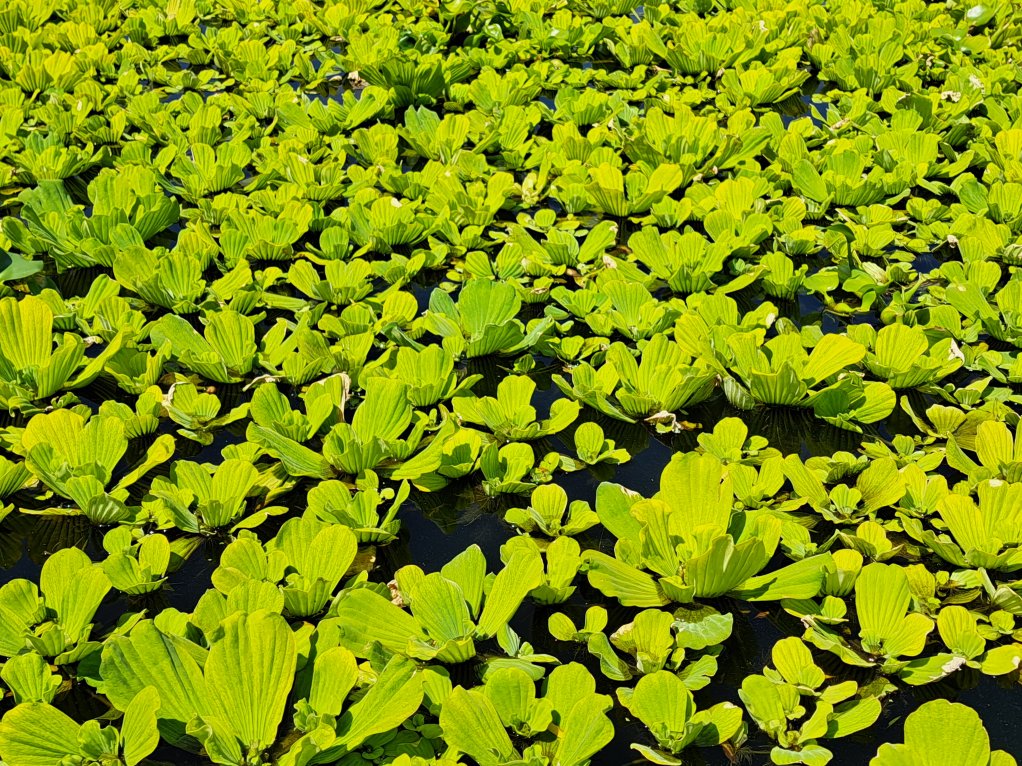Rand Water launches programme to rid Vaal river of invasive water lettuce


OVERWHELMING The extent of growth of the water lettuce has not been seen elsewhere in South Africa
Rand Water has embarked on a programme to clear the invasive water lettuce currently overwhelming the Vaal river.
The water utility, after being approached by communities, had been working with Rhodes University and various technical experts, as well as local communities, to develop options to mitigate the increasing challenge of invasive plants in the Vaal Barrage.
The programme entails an integrated approach that combines physical removal, chemical control and biological agent control, said Rand Water corporate services GM Mbuyiswa Makhubela during a small ceremonial release on February 15 at Stonehaven on the Vaal, in Vanderbijlpark, prior to the wider release of biological agents.
The team released hundreds of weevils as biocontrol agents at several sites across the Barrage area, including Rietspruit, Cloudy Creek, Leeuspruit and Taaibosspruit, as part of an ongoing longer-term programme to frequently release the insects in the region to control the plants.
The release of this first batch followed the physical removal of the invasive aquatic plants by communities and the spraying of specifically formulated chemicals approved by the Department of Water and Sanitation as well as the Department of Forestry, Fisheries and the Environment at very controlled, specific sublethal dosage rates.
While biological control, such as the weevils and hoppers, can control the majority of these floating aquatic species over the long term, there is a need to get rid of a large majority of these plants as quickly as possible, which is where the manual removal or the chemical treatment plays a significant role in preventing further spread.
However, public complaints and concerns over the use of glyphosate, the chemical used to clear alien invasive plants from the Vaal river, have led Forestry, Fisheries and the Environment Minister Barbara Creecy and Water and Sanitation Minister Senzo Mchunu, along with other relevant parties, to embark on a review and determine whether the clearing methods followed were in line with the regulatory environment and to devise a future plan that ensures that the clearing of the alien invasive plants is done in a manner that poses no harm to the environment.
Once that process is concluded, the departments will issue a further statement on the way forward.
Rand Water environmental services manager Dr Lesley Hoy tells Engineering News & Mining Weekly that the use of the chemicals received all the required authorisations and the teams had followed all protocols and compliance within the guidelines provided to ensure that all risks related to physical removal, chemical control and the use of biological agents were mitigated.
He explains that the extent of growth of the water lettuce has not been seen elsewhere in South Africa.
“The extent of the problem is almost a new facet to deal with. Added to that, we do not only have water lettuce, but hyacinth as well. Unfortunately, the weather and the [poor] water quality have not helped. So the growth has continued unabated,” he says, adding that its mitigation is critical to prevent further damage to the region’s aquatic life, tourism and the economy.
The invasive species, which evolved under very dynamic conditions where they can tolerate all kinds of aquatic ecosystems, become so invasive, owing to an endless supply of food, the absence of natural controlling regulations and South Africa’s short, slow rivers, impoundments and still dams and rivers with slow moving water, as well as subpar water quality and heat, explains Centre for Biological Control deputy director Dr Julie Coetzee.
Released on to the aquatic plants, the biological agents eat and damage the plants, which eventually kills them off, and while it does take time and requires patience, their long-term use on the invasive plants is safe, environment- friendly and sustainable, reducing the need for chemical control, Coetzee explains.
Hoy tells Engineering News & Mining Weekly that the programme will be ongoing with the release of biological agents every few weeks, with the insects being reared in Grahamstown and at the newly established hot house within Rand Water’s nursery in Alberton for future releases.
Rhodes University developed a monitoring application for the project, which provides satellite imagery that gets uploaded and updated once a week, enabling Rand Water and other interested stakeholders to monitor the extent of the growth of the water lettuce, the extent of the problem and to see where it has had impact.
“As part of this, we will also be engaging with the community to set up their own growing stations under the auspices of Rhodes University and Rand Water,” says Hoy, noting that the approaches can be coordinated to obtain data for future use and mitigation should these invasive plants arise somewhere else in South Africa.
While the team is releasing relatively few weevils and hoppers during the summer period, the aim is to gear up and grow exponentially, so that by spring, the biological agents can be released on a large scale as early as the temperatures will allow.
“The phase between the growth and the germination of the invasive species occurs quicker than what the weevils recuperate after winter. Our aim is that, if we have stock of weevils and hopper, we can introduce them early in spring or later this year,” he says.
Comments
Press Office
Announcements
What's On
Subscribe to improve your user experience...
Option 1 (equivalent of R125 a month):
Receive a weekly copy of Creamer Media's Engineering News & Mining Weekly magazine
(print copy for those in South Africa and e-magazine for those outside of South Africa)
Receive daily email newsletters
Access to full search results
Access archive of magazine back copies
Access to Projects in Progress
Access to ONE Research Report of your choice in PDF format
Option 2 (equivalent of R375 a month):
All benefits from Option 1
PLUS
Access to Creamer Media's Research Channel Africa for ALL Research Reports, in PDF format, on various industrial and mining sectors
including Electricity; Water; Energy Transition; Hydrogen; Roads, Rail and Ports; Coal; Gold; Platinum; Battery Metals; etc.
Already a subscriber?
Forgotten your password?
Receive weekly copy of Creamer Media's Engineering News & Mining Weekly magazine (print copy for those in South Africa and e-magazine for those outside of South Africa)
➕
Recieve daily email newsletters
➕
Access to full search results
➕
Access archive of magazine back copies
➕
Access to Projects in Progress
➕
Access to ONE Research Report of your choice in PDF format
RESEARCH CHANNEL AFRICA
R4500 (equivalent of R375 a month)
SUBSCRIBEAll benefits from Option 1
➕
Access to Creamer Media's Research Channel Africa for ALL Research Reports on various industrial and mining sectors, in PDF format, including on:
Electricity
➕
Water
➕
Energy Transition
➕
Hydrogen
➕
Roads, Rail and Ports
➕
Coal
➕
Gold
➕
Platinum
➕
Battery Metals
➕
etc.
Receive all benefits from Option 1 or Option 2 delivered to numerous people at your company
➕
Multiple User names and Passwords for simultaneous log-ins
➕
Intranet integration access to all in your organisation



















